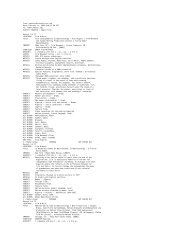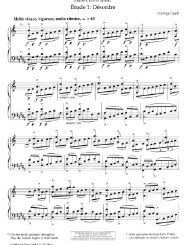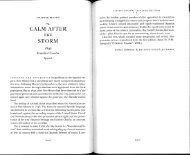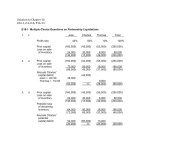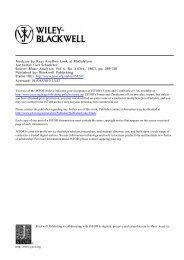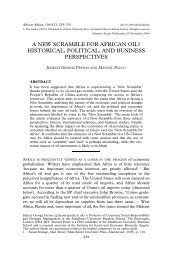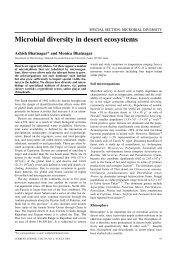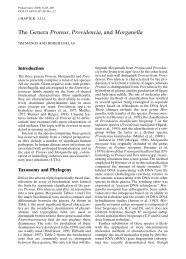A novel chemical fossil of palaeo sea ice: IP25
A novel chemical fossil of palaeo sea ice: IP25
A novel chemical fossil of palaeo sea ice: IP25
- TAGS
- novel
- fossil
- palaeo
- www.ic.ucsc.edu
You also want an ePaper? Increase the reach of your titles
YUMPU automatically turns print PDFs into web optimized ePapers that Google loves.
Abstract<br />
A <strong>novel</strong> <strong>chemical</strong> <strong>fossil</strong> <strong>of</strong> <strong>palaeo</strong> <strong>sea</strong> <strong>ice</strong>: IP 25<br />
Simon T. Belt a, *, Guillaume Massé a , Steven J. Rowland a , Michel Poulin b ,<br />
Christine Michel c , Bernard LeBlanc c<br />
a Petroleum and Environmental Geochemistry Group, School <strong>of</strong> Environmental Sciences, University <strong>of</strong> Plymouth, Drake Circus,<br />
Plymouth, Devon PL4 8AA, UK<br />
b Re<strong>sea</strong>rch Division, Canadian Museum <strong>of</strong> Nature, P.O. Box 36, Ottawa, Ont., Canada K1P 6P4<br />
c Freshwater Institute, Fisheries and Oceans Canada, 501 University Crescent, Winnipeg, Man., Canada R3T 2N6<br />
Received 12 July 2006; received in revised form 20 September 2006; accepted 26 September 2006<br />
A unique and <strong>novel</strong> organic compound has been detected in <strong>sea</strong> <strong>ice</strong> samples from three locations in the Canadian Arctic,<br />
thousands <strong>of</strong> kilometers apart. It is likely that this biomarker is produced by diatoms living in the <strong>sea</strong> <strong>ice</strong> and we provide<br />
evidence which suggests that the compound, a C25 monounsaturated hydrocarbon (<strong>IP25</strong>), may be a specific, sensitive and<br />
stable proxy for <strong>sea</strong> <strong>ice</strong> in sediments over at least the Holocene. Since it has not been reported before, we confirmed its<br />
identity by synthesis and used the synthesized compound as a reference for quantifying IP 25 in a range <strong>of</strong> sediments from<br />
an East-West transect in the Canadian Arctic. The recent sediments are either <strong>sea</strong>sonally covered with <strong>ice</strong> or have permanent<br />
<strong>ice</strong> cover. Older sediments containing <strong>IP25</strong> have been dated using radiocarbon methods to at least 9000 yr. If the concept<br />
proves generally applicable, monitoring <strong>IP25</strong> in further sediment cores along with other accepted proxies, should allow<br />
movements in the position <strong>of</strong> the <strong>ice</strong> edge throughout the Holocene (at least) to be better determined, which is essential for<br />
accurate calibration <strong>of</strong> climate prediction models. A similar approach for Antarctic samples <strong>of</strong> <strong>ice</strong> and sediments would<br />
also seem worthwhile.<br />
Ó 2006 Elsevier Ltd. All rights reserved.<br />
1. Introduction<br />
1.1. Polar <strong>sea</strong> <strong>ice</strong> and climate change<br />
Organic Geochemistry 38 (2007) 16–27<br />
Polar <strong>sea</strong> <strong>ice</strong> plays a fundamental role in determining<br />
the rate <strong>of</strong> global climate change by influencing<br />
the exchange <strong>of</strong> heat and moisture between<br />
polar oceans and the atmosphere, since it reflects<br />
*<br />
Corresponding author. Tel.: +44 1752 233042; fax: +44 1752<br />
232406.<br />
E-mail address: sbelt@plymouth.ac.uk (S.T. Belt).<br />
0146-6380/$ - see front matter Ó 2006 Elsevier Ltd. All rights reserved.<br />
doi:10.1016/j.orggeochem.2006.09.013<br />
Organic<br />
Geochemistry<br />
www.elsevier.com/locate/orggeochem<br />
much <strong>of</strong> the incoming solar radiation (the albedo<br />
effect; Thomas and Dieckmann, 2003). In addition,<br />
it contributes to circulation models <strong>of</strong> numerous<br />
oceanic processes (e.g. thermohaline circulation),<br />
many <strong>of</strong> which have further positive feedback mechanisms<br />
in relation to <strong>sea</strong> <strong>ice</strong> extent (Thomas and<br />
Dieckmann, 2003). Consequently, the retreat <strong>of</strong><br />
<strong>sea</strong> <strong>ice</strong> from the Arctic regions during the last 30<br />
years has been receiving considerable attention<br />
(Johannessen et al., 1995, 1999; De la Mare, 1997;<br />
Vinnikov et al., 1999; Francis et al., 2005; Stroeve<br />
et al., 2005; Divine and Dick, 2006) It is therefore
essential to improve our knowledge <strong>of</strong> historical <strong>sea</strong><br />
<strong>ice</strong> fluctuations and the associated variations in climate<br />
in order to better refine and calibrate models<br />
<strong>of</strong> future climate change. In recent times (the last<br />
30 years), satellite imaging methods have enabled<br />
<strong>sea</strong> <strong>ice</strong> coverage determination to become both rigorous<br />
and routine (Johannessen et al., 1995, 1999;<br />
Vinnikov et al., 1999; Francis et al., 2005; Stroeve<br />
et al., 2005), while historical <strong>sea</strong>ling and whaling<br />
records provide some information for the last 300<br />
years (De la Mare, 1997; Divine and Dick, 2006).<br />
However, there is a paucity <strong>of</strong> meaningful records<br />
<strong>of</strong> <strong>sea</strong> <strong>ice</strong> over longer timescales, principally since<br />
the melt process leaves behind a relatively poor geological<br />
record. Of the proxy measures that exist for<br />
the determination <strong>of</strong> <strong>palaeo</strong> <strong>sea</strong> <strong>ice</strong> cover, one<br />
method relies on the preservation in sediments <strong>of</strong><br />
<strong>fossil</strong> sil<strong>ice</strong>ous frustules (or skeleta) <strong>of</strong> diatomaceous<br />
<strong>sea</strong> <strong>ice</strong> algae (Thomas and Dieckmann, 2003; Gersonde<br />
and Zielinski, 2000). These microalgae can<br />
be distinguished from open water diatoms or flora<br />
found in multi-year <strong>ice</strong>. The <strong>sea</strong> <strong>ice</strong> diatoms inhabit<br />
the underside <strong>of</strong> first year <strong>ice</strong> at the interface with<br />
nutrient-rich <strong>sea</strong>water, where light penetration<br />
through the <strong>ice</strong> is adequate and where microscopic<br />
capillaries and brine pockets provide a unique ecological<br />
niche (Thomas and Dieckmann, 2003).<br />
When the <strong>ice</strong> melts, or the microalgae die or are<br />
grazed by zooplankton, the silica and organic compounds<br />
<strong>of</strong> which these microalgae (diatoms) are<br />
comprised, settle through the water column before<br />
reaching the sediment. However, poor preservation<br />
<strong>of</strong> the thin sil<strong>ice</strong>ous frustules <strong>of</strong> diatoms sometimes<br />
makes it difficult to carry out unambiguous identification,<br />
and the majority <strong>of</strong> organic compounds<br />
found in <strong>sea</strong> <strong>ice</strong> diatoms are not preserved well<br />
and suffer biodegradation in the water column or<br />
sediment. Of those which do survive, most are<br />
non-specific for <strong>sea</strong> <strong>ice</strong> diatoms, rendering them<br />
unsuitable as specific <strong>sea</strong> <strong>ice</strong> proxies.<br />
In order to be useful as an indicator <strong>of</strong> the presence<br />
<strong>of</strong> former <strong>sea</strong> <strong>ice</strong>, a <strong>chemical</strong> biomarker must<br />
originate within the <strong>sea</strong> <strong>ice</strong> and be absent from open<br />
waters (i.e. be specific), be sufficiently resistant to<br />
degradation in the water column and to other diagenetic<br />
changes in the sediment (i.e. be stable) and be<br />
produced in sufficient quantity for straightforward<br />
detection, both amongst the numerous other compounds<br />
in sediments and with meaningful geological<br />
resolution (i.e. be sensitive). The ketones measured<br />
in the well known U k0<br />
37 alkenone index, which has<br />
provided a useful and widely used <strong>chemical</strong> proxy<br />
S.T. Belt et al. / Organic Geochemistry 38 (2007) 16–27 17<br />
for the determination <strong>of</strong> mean summer or spring<br />
<strong>sea</strong> surface temperatures <strong>of</strong> open waters (e.g. Brassell<br />
et al., 1986), have many <strong>of</strong> these attributes.<br />
1.2. Diatom specific isoprenoids as a new <strong>chemical</strong><br />
proxy<br />
C25 and C30 highly branched isoprenoid (HBI)<br />
alkenes, known as haslenes and rhizenes, respectively,<br />
are biosynthesised by a limited number <strong>of</strong><br />
diatom genera; notably some Haslea spp., Rhizosolenia<br />
spp., Pleurosigma spp. and some Navicula<br />
spp. (Volkman et al., 1994; Massé et al., 2004; Sinninghe<br />
Damsté et al., 2004). In Haslea ostrearia<br />
(Gaillon) Simonsen, the extent <strong>of</strong> unsaturation in<br />
the haslenes co-varies with culture temperature.<br />
Thus, tetra- and tri-unsaturated haslenes are produced<br />
as the major isomers at 25 °C and 15 °C<br />
respectively, while at 5 °C, diunsaturated haslenes<br />
(hasladienes) are biosynthesized as the major isomers<br />
(Rowland et al., 2001). Haslea spp. have been<br />
identified as minor members <strong>of</strong> both Arctic (Poulin,<br />
1990; Booth and Horner, 1998; Riedel et al., 2003)<br />
and Antarctic (Pakhomov et al., 2001) <strong>sea</strong> <strong>ice</strong> diatom<br />
populations and hasladienes have been found<br />
in mixed diatom populations obtained from Antarctic<br />
<strong>sea</strong> <strong>ice</strong> (Nichols et al., 1988; Johns et al., 1999).<br />
We hypothesised that a similar dependence <strong>of</strong><br />
unsaturation on temperature might lead to the production<br />
<strong>of</strong> monounsaturated haslenes in <strong>sea</strong> <strong>ice</strong> populations<br />
<strong>of</strong> Haslea spp., and that, on the melting or<br />
grazing <strong>of</strong> the <strong>ice</strong>, such compounds might be better<br />
preserved in sediments than the more unsaturated<br />
HBIs, including trienes and tetraenes. Previously,<br />
synthesized haslane (Robson and Rowland, 1986)<br />
and mono-unsaturated haslenes have been shown<br />
to be relatively resistant to biodegradation compared<br />
to unbranched alkanes and alkenes (Robson<br />
and Rowland, 1988) and, even hasladienes undergo<br />
little diagenetic reaction compared with the more<br />
unsaturated HBIs (Belt et al., 2000b), suggesting<br />
that the monoenes would be even more stable. As<br />
such, HBI monoenes should have the potential to<br />
serve as proxy measures <strong>of</strong> contemporary and historical<br />
<strong>sea</strong> <strong>ice</strong> when detected in polar <strong>ice</strong> and sediments<br />
respectively. Although we were aware <strong>of</strong> a<br />
limited number <strong>of</strong> reports <strong>of</strong> haslene monoenes <strong>of</strong><br />
unknown biological origin in sediments from temperate<br />
and sub-tropical environments (Dunlop and<br />
Jefferies, 1985; Xu et al., 2006), the specificity <strong>of</strong><br />
the biosynthetic process in the genus Haslea Simonsen<br />
(Massé et al., 2004), encouraged us to postulate
18 S.T. Belt et al. / Organic Geochemistry 38 (2007) 16–27<br />
that monoenes in <strong>sea</strong> <strong>ice</strong> and/or polar sediments<br />
might be structurally specific and different from<br />
those found in non-polar regions. In order to test<br />
this hypothesis, we examined the hydrocarbon content<br />
<strong>of</strong> <strong>sea</strong> <strong>ice</strong> obtained from three distinct regions<br />
<strong>of</strong> the Canadian Arctic, together with recent and<br />
ancient (Holocene) sediments collected from across<br />
the Canadian sub- and High Arctic regions, including<br />
those <strong>sea</strong>sonally covered with <strong>ice</strong>. We also examined<br />
the hydrocarbon extracts from assemblages <strong>of</strong><br />
open water phytoplankton in order to determine<br />
whether the <strong>chemical</strong>s present in <strong>sea</strong> <strong>ice</strong> were <strong>sea</strong><br />
<strong>ice</strong> restricted or not.<br />
2. Experimental<br />
2.1. Sea <strong>ice</strong> and sediment sampling<br />
Sea <strong>ice</strong> sampling (Fig. 1) was performed in<br />
McDougall Sound (May 2003; Site 1), Franklin<br />
Bay (May 2004; Site 2) and Button Bay (April<br />
2005; Site 3). Ice samples were collected using a<br />
MARK II <strong>ice</strong> corer at a site where snow cover<br />
was at a minimum. For diatom analysis, the bottom<br />
sections (5 cm) <strong>of</strong> three cores were combined in a<br />
dark isothermal container. In the laboratory, these<br />
sections were allowed to melt at room temperature<br />
(15 °C) and two sub-samples (25 ml) were preserved<br />
with 1% formaldehyde (1 ml) prior to analysis. For<br />
each sampling site, a further three <strong>ice</strong> cores were collected<br />
and kept frozen for hydrocarbon analysis.<br />
Sediment material was obtained in three stages.<br />
First, surface and down-core material (seven locations,<br />
NOW-1 – NOW-5, WEI-1,2; Fig. 1, Table<br />
1) was obtained from the Geological Survey <strong>of</strong> Canada<br />
(Atlantic Division, Bedford Institute <strong>of</strong> Oceanography).<br />
Second, surface sediment samples were<br />
collected from Button Bay (April 2005; ARC-8;<br />
Fig. 1, Table 2) using an Ekman grab sampler.<br />
Third, combinations <strong>of</strong> surface sediment (box<br />
core; 50 cm · 50 cm · 80 cm), trigger weight cores<br />
(99.2 mm internal diameter) and piston cores<br />
(99.2 mm internal diameter) were obtained from<br />
seven locations (ARC-1 to ARC-7; Fig. 1, Table<br />
2) during the CCGS Amundsen Leg 1 ArcticNet<br />
cruise (August/September 2005). Sub-samples <strong>of</strong><br />
surface and core material ( 20 °C) and the remaining<br />
core material (< 4 °C) were stored in the dark<br />
prior to analysis.<br />
2.2. Diatom analysis<br />
Diatom material from <strong>sea</strong> <strong>ice</strong> was prepared<br />
according to Hendey (1974). Cleaned diatom frus-<br />
Fig. 1. Map <strong>of</strong> sampling locations for <strong>sea</strong> <strong>ice</strong> and sediment samples. , Sea <strong>ice</strong>; , NOW sediments; , WEI sediments; , ARC sediments.<br />
Individual numbering corresponds to specific locations cited in the text.
Table 1<br />
Summary <strong>of</strong> Arctic sediments corresponding to North Water (NOW) and Ellesmere Island (WEI) regions <strong>of</strong> the Canadian High Arctic<br />
Sample Cruise<br />
number<br />
Table 2<br />
Summary <strong>of</strong> Arctic sediments obtained during the ArcticNet 2005 cruise and from Churchill, Hudson Bay (NB IP 25 concentrations for<br />
ARC-5 have not been determined)<br />
Sediment ArcticNet stations Water<br />
depth (m)<br />
tules were examined with light microscopy and, to<br />
achieve unambiguous identification <strong>of</strong> some <strong>of</strong> the<br />
species, some preparations were examined using<br />
scanning electron microscopy (Jeol 6400F).<br />
2.3. Lipid analysis<br />
Hole Water<br />
depth (m)<br />
NOW-1 84015 71 538 Annual/<br />
<strong>sea</strong>sonal<br />
NOW-2 84015 61 578 Annual/<br />
<strong>sea</strong>sonal<br />
NOW-3 84015 67 677 Annual/<br />
<strong>sea</strong>sonal<br />
NOW-4 91039 8twc 663 Annual/<br />
<strong>sea</strong>sonal<br />
NOW-5 91039 26d 450 Annual/<br />
<strong>sea</strong>sonal<br />
Sea <strong>ice</strong> sections (200–300 ml) were freeze-dried<br />
and an internal standard was added to permit quantification<br />
using GC–MS (7-hexylnonadecane,<br />
1.5 lg sample 1 ). The freeze-dried samples were<br />
extracted using a mixture <strong>of</strong> CH2Cl2/CH3OH (50/<br />
50; 5 ml) to yield a total organic extract (TOE).<br />
The TOE was saponified with 2 ml 5% KOH in<br />
CH3OH/water (80/20) at 80 °C for 30 min to hydrolyse<br />
triglyceride esters <strong>of</strong> fatty acids. The nonsaponifiable<br />
lipids (NSLs) were re-extracted into<br />
hexane (3 · 1 ml) and dried over anhydrous<br />
Na2SO4. Following derivatisation (100 ll BSTFA-<br />
TMCS (99/1), 30 min at 70 °C), these NSLs were<br />
analysed using GC–MS and purified using a two<br />
stage chromatography procedure if necessary<br />
(Section 2.4).<br />
Ice cover Date <strong>of</strong><br />
collection<br />
Ice cover Date <strong>of</strong><br />
collection<br />
Latitude (N) Longitude<br />
(W)<br />
23-09-1984 75°23.58 0 79°21.30 0 0.53<br />
22-09-1984 76°12.90 0 83°03.18 0 0.56<br />
22-09-1984 76°01.38 0 82°35.70 0 0.33<br />
27-08-1991 77°15.96 0 74°19.92 0 0.29<br />
06-09-1991 75°29.52 0 78°10.98 0 0.16<br />
WEI-1 85200 38 134 Permanent 07-08-1985 81°01.80 0 96°38.28 0 n.d.<br />
WEI-2 85200 50 115 Permanent 10-08-1985 81°02.58 0 96°28.38 0 n.d.<br />
n.d., not detected.<br />
S.T. Belt et al. / Organic Geochemistry 38 (2007) 16–27 19<br />
Latitude<br />
(N)<br />
Longitude<br />
(W)<br />
ARC-1 2 – North Water 703 Annual/<strong>sea</strong>sonal 20-08-2005 77°49.75 0 74°39.97 0 0.31<br />
ARC-2 3 – Lancaster Sound 811 Annual/<strong>sea</strong>sonal 23-08-2005 74°02.95 0 79°54.41 0 0.33<br />
ARC-3 4 – Barrow Strait 347 Annual/<strong>sea</strong>sonal 24-08-2005 74°16.05 0 91°06.38 0 1.52<br />
ARC-4 6 – Victoria Strait 61 Annual/<strong>sea</strong>sonal 27-08-2005 69°09.94 0 100°41.72 0 0.37<br />
ARC-5 7 – Dease Strait 112 Annual/<strong>sea</strong>sonal 30-08-2005 68°59.45 0 106°34.27 0 –<br />
ARC-6 11 – Franklin Bay 253 Annual/<strong>sea</strong>sonal 10-09-2005 70°19.49 0 126°23.50 0 0.14<br />
ARC-7 12 – Amundsen Gulf 219 Annual/<strong>sea</strong>sonal 13-09-2005 69°54.81 0 122°57.96 0 0.16<br />
ARC-8 Button Bay, Churchill 15 Annual/<strong>sea</strong>sonal 03-05-2005 58°50.00 0 94°20.00 0 0.15<br />
Individual compounds were identified on the<br />
basis <strong>of</strong> comparison between their GC retention<br />
ind<strong>ice</strong>s and mass spectra with those <strong>of</strong> authentic<br />
standards. A similar procedure was used for sediment<br />
samples except that the internal standard<br />
(1.5 lg) was added to the wet sediment material<br />
(5 g) immediately before extraction.<br />
2.4. Purification <strong>of</strong> individual compounds<br />
IP 25 (lg/g<br />
w.w.)<br />
<strong>IP25</strong><br />
(lg/g w.w.)<br />
Hydrocarbons were separated from phytol, sterols<br />
and other compounds in the NSLs using open<br />
column chromatography (50:1 SiO2:NSLs (w/w)).<br />
The hydrocarbons were eluted with hexane (5 column<br />
volumes) while the more polar compounds were<br />
obtained as a single fraction using CH 2Cl 2 (2 column<br />
volumes) followed by (CH 3) 2CO (2 column volumes).<br />
In some cases, individual lipids from the<br />
hydrocarbon fraction were then separated with silver<br />
ion chromatography (5:95 AgNO3:SiO2). Saturated<br />
hydrocarbons were eluted with hexane (5 column<br />
volumes), monoene 1 was obtained using CH2Cl2
20 S.T. Belt et al. / Organic Geochemistry 38 (2007) 16–27<br />
(2 column volumes) and the more unsaturated<br />
alkenes were eluted using a mixture <strong>of</strong> CH2Cl2/<br />
(CH3)2CO (60/40, 2 column volumes). Structures <strong>of</strong><br />
the C25 HBI alkenes discussed are shown in Fig. 2.<br />
2.5. Lipid analysis<br />
1 2<br />
Fig. 2. Chemical structures <strong>of</strong> IP 25 (1), C 25 HBI monoene (2) and<br />
C25 HBI diene (3). The double bond in <strong>IP25</strong> is located at C23–24.<br />
A Hewlett-Packard 5890 Series II gas chromatograph<br />
(GC), fitted with a 30 m fused silica HP-1 column<br />
(0.25 mm i.d., 0.25 lm film) and coupled to a<br />
HO<br />
HO<br />
Br<br />
Br<br />
Br<br />
Br<br />
3<br />
(iv)<br />
5970 Series mass selective detector (MSD) was used<br />
to perform gas chromatography–mass spectrometry<br />
(GC–MS) analysis. The GC oven temperature was<br />
programmed from 40 to 300 °C at5°C min 1 and<br />
held at the final temperature for 10 min. Operating<br />
conditions for the mass spectrometer were 280 °C<br />
for the ion source temperature and 70 eV for the<br />
ionisation energy. Spectra (m/z 40–550) were collected<br />
using Hewlett-Packard MS-Chemstation<br />
s<strong>of</strong>tware.<br />
2.6. Synthesis <strong>of</strong> C25 HBI monoenes 1 and 2<br />
2.6.1. Monoene 1<br />
Synthesis <strong>of</strong> 1 was performed via a 5 step procedure<br />
as shown in Fig. 3. To diene 3 (5 mg,<br />
14.4 lmol) in CH2Cl2 (1 ml) was added m-chloroperoxybenzoic<br />
acid (MCPBA) (6.25 mg, 14.4 lmol)<br />
dissolved in CH2Cl2 (1 ml) and the resulting solution<br />
was heated at 50 °C for 4 h. Following solvent<br />
evaporation (N 2), the reaction mixture was redissolved<br />
in hexane and subjected to column chromatography,<br />
whereby unreacted 3 and epoxide 4<br />
(3 mg) were obtained by elution with hexane and<br />
(i)<br />
3 4<br />
6<br />
7<br />
(iii)<br />
(v)<br />
Fig. 3. Synthetic scheme for the preparation <strong>of</strong> the C 25 monoene (IP 25) found in Arctic <strong>sea</strong> <strong>ice</strong> and sediments: (i) MCPBA, CH 2Cl 2,4h,<br />
50 °C; (ii) TBABr3, CH2Cl2, 0.5 h, 25 °C; (iii) HClO4, THF/H2O, 1 h, 25 °C; (iv) PtO2/H2, CH3CO2H, 5 h, 25 °C; (v) Zn, t-BME,<br />
CH3CO2H, 12 h, 25 °C.<br />
(ii)<br />
Br<br />
Br<br />
O<br />
O<br />
5<br />
1
CH2Cl2, respectively. Epoxide 4 (3 mg, 8.2 lmol) in<br />
CH2Cl2 (1 ml) was added to 2 equiv. <strong>of</strong> tetra-n-butylammonium<br />
tribromide in CH2Cl2 (1 ml) and the<br />
resulting solution left at room temperature (1 h).<br />
After solvent evaporation (N 2), the reaction mixture<br />
was redissolved in hexane and subjected to column<br />
chromatography, whereby the dibromo-epoxide 5<br />
(4.1 mg) was obtained by elution with hexane. Following<br />
reaction <strong>of</strong> dibromo-epoxide 5 (4.1 mg,<br />
7.8 lmol; H2O/THF (3 ml, 40/60)) with HClO4<br />
(75 ll; 3 h), the reaction was quenched with saturated<br />
NaHCO3 (3 ml) and the products re-extracted<br />
into hexane (2 · 3 ml). Solvent removal yielded the<br />
dibromo-diol 6 (3.5 mg). H 2 was bubbled through<br />
a solution <strong>of</strong> 6 (3.5 mg, 6.4 lmol) in CH 3CO 2H<br />
(1 ml) in the presence <strong>of</strong> PtO2 Æ 2H2O (0.05 g). After<br />
5 h, the sample was filtered through a glass Pasteur<br />
pipette containing anhydrous sodium Na2SO4. Following<br />
solvent evaporation (N2), the reaction mixture<br />
was redissolved in hexane and subjected to<br />
column chromatography, whereby dibromide 7<br />
(1.9 mg) and unreacted 6 were obtained by elution<br />
with hexane and CH 2Cl 2, respectively. Dibromide<br />
7 (1.9 mg, 3.7 lmol) was dissolved in a mixture <strong>of</strong><br />
tert-butyl methyl ether (2 ml) and CH3CO2H<br />
(1 ml); 20 mg <strong>of</strong> zinc dust was added and the mixture<br />
was stirred at room temperature (12 h). After<br />
filtering (Na2SO4) and removal <strong>of</strong> the solvent (N2),<br />
the reaction mixture was redissolved in H 2O (2 ml)<br />
and the products reextracted into hexane<br />
(2 · 3 ml). Removal <strong>of</strong> the hexane yielded 1.1 mg<br />
<strong>of</strong> 1.<br />
S.T. Belt et al. / Organic Geochemistry 38 (2007) 16–27 21<br />
2.6.2. Monoene 2<br />
H2 was bubbled through a solution <strong>of</strong> diene 3<br />
obtained previously by extraction from H. ostrearia<br />
(5 mg, 14.4 lmol) in hexane (5 ml) in the presence <strong>of</strong><br />
PtO2 Æ 2H2O (0.1 g). Aliquots were removed at regular<br />
intervals (each 30 s) to monitor the hydrogenation<br />
progress with GC–MS. Following<br />
hydrogenation, samples were filtered through a glass<br />
Pasteur pipette containing anhydrous Na2SO4 and<br />
the solvent was removed under N2 prior to analysis.<br />
Monoene 2 was separated from 3 and its saturated<br />
analogue using silver ion chromatography as<br />
described above to yield 0.7 mg (2 lmol) <strong>of</strong> pure 2.<br />
2.6.3. NMR characterisation <strong>of</strong> C 25 monoene 1<br />
1 H and 13 C NMR spectroscopy were used to<br />
characterise the C25 monoene 1. Spectra were<br />
obtained using a Jeol EX 270 spectrometer operating<br />
at 270 and 68 MHz for 1 H and 13 C respectively,<br />
and processed using DELTA s<strong>of</strong>tware. Spectra were<br />
recorded in CDCl 3 and <strong>chemical</strong> shifts were referenced<br />
relative to residual proton signals or to the<br />
central line <strong>of</strong> 13 C multiplets <strong>of</strong> the solvent ( 1 H:<br />
7.24 ppm, 13 C: 77.0 ppm). Selected NMR data: 1 H<br />
(d/ppm): 5.69 (m, 1H, –CH@CH2), 4.92 (m, 2H, –<br />
CH@CH2); 13 C(d/ppm): 145.1 (CH@CH2), 114.3<br />
(CH@CH2).<br />
2.7. Dating <strong>of</strong> core material<br />
Determination <strong>of</strong> the age <strong>of</strong> the longest core<br />
obtained from the ArcticNet cruise was achieved<br />
Table 3<br />
Summary <strong>of</strong> phytoplankton samples collected across the Canadian High Arctic during the ArcticNet cruise in 2005<br />
Sample ARCTICNET station Date <strong>of</strong> collection Water depth (m) Latitude Longitude<br />
PHK-1 Pond Inlet 14-08-2005 751 72.47 0 039 00 78.07 0 505 00<br />
PHK-2 BA01 – North Water 16-08-2005 676 76.17 0 924 00 71.24 0 525 00<br />
PHK-3 BA02 – North Water 17-08-2005 446 76.15 0 491 00 74.36 0 321 00<br />
PHK-4 BA03 – North Water 18-08-2005 348 76.23 0 114 00 77.21 0 208 00<br />
PHK-5 BA04 – North Water 21-08-2005 478 75.14 0 280 00 74.59 0 075 00<br />
PHK-6 3 – Lancaster Sound 22-08-2005 817 74.02 0 895 00 79.55 0 684 00<br />
PHK-7 4 – Barrow Strait 24-08-2005 332 74.15 0 519 00 91.11 0 273 00<br />
PHK-8 6 – Victoria Strait 27-08-2005 65 69.10 0 092 00 100.42 0 145 00<br />
PHK-9 7 – Dease Strait 30-08-2005 120 69.00 0 054 00 106.35 0 009 00<br />
PHK-10 204 02-09-2005 65 71.08 0 473 00 128.11 0 283 00<br />
PHK-11 CA-05-05 03-09-2005 211 71.16 0 727 00 127.28 0 988 00<br />
PHK-12 10 – Beaufort Sea 05-09-2005 220 71.33 0 500 00 140.04 0 200 00<br />
PHK-13 CA-04-05 06-09-2005 335 71.05 0 027 00 133.34 0 289 00<br />
PHK-14 CA-08-05 09-09-2005 414 71.00 0 000 00 125.55 0 000 00<br />
PHK-15 11a – Franklin Bay 11-09-2005 263 70.20 0 264 00 126.22 0 106 00<br />
PHK-16 11b – Franklin Bay 11-09-2005 256 70.20 0 310 00 126.21 0 675 00<br />
PHK-17 CA-18-04 12-09-2005 609 70.39 0 174 00 122.59 0 450 00<br />
PHK-18 12 – Amundsen Gulf 13-09-2005 219 69.54 0 813 00 122.57 0 957 00
22 S.T. Belt et al. / Organic Geochemistry 38 (2007) 16–27<br />
using radiocarbon ( 14 C) dating <strong>of</strong> foraminifera<br />
shells [Neogloboquadrina pachyderma (s)] isolated<br />
from the base <strong>of</strong> the core obtained from Lancaster<br />
Sound (641 cm). A sub-sample <strong>of</strong> the sediment<br />
(50 g) was air-dried, sieved (63 lm) and the foraminifera<br />
isolated by hand under a microscope.<br />
Approximately 200 specimens were analysed using<br />
accelerator mass spectrometry (Beta Analytic Inc.,<br />
USA).<br />
2.8. Phytoplankton collection<br />
Surface and near surface (1–50 m water depth)<br />
samples <strong>of</strong> phytoplankton were obtained via horizontal<br />
and vertical trawling (75 lm) <strong>of</strong> late summer<br />
<strong>ice</strong>-free waters across the entire East-West transect<br />
<strong>of</strong> the Canadian High Arctic during the ArcticNet<br />
cruise (August/September 2005, Table 3). Aliquots<br />
<strong>of</strong> the phytoplankton concentrates were preserved<br />
(Lugol) prior to diatom analysis. The remaining<br />
concentrates were extracted and analysed as per<br />
other lipid analyses described previously.<br />
3. Results and discussion<br />
3.1. Analysis <strong>of</strong> Arctic <strong>sea</strong> <strong>ice</strong> and phytoplankton<br />
assemblages<br />
As part <strong>of</strong> an initial study, <strong>sea</strong> <strong>ice</strong> samples from<br />
three well-separated regions <strong>of</strong> the Canadian suband<br />
High Arctic (McDougall Sound, Franklin Bay<br />
and Button Bay; Fig. 1) were obtained. In all three<br />
cases, analysis with light and electron microscopy<br />
revealed the presence <strong>of</strong> characteristic Arctic <strong>sea</strong><br />
<strong>ice</strong> diatoms, including members <strong>of</strong> the common genera<br />
Nitzschia Hassall, Fragilariopsis Hustedt,<br />
Entomoneis Ehrenberg, Navicula Bory and Pseudogomphonema<br />
Medlin (Thomas and Dieckmann,<br />
2003; Poulin, 1990). Significantly, and as expected<br />
from previous reports (Poulin, 1990; Booth and<br />
Horner, 1998; Riedel et al., 2003), low abundances<br />
(1–3%) <strong>of</strong> a number <strong>of</strong> Haslea spp. were present in<br />
each case. Thus, Haslea crucigeroides (Hustedt)<br />
Simonsen, Haslea vitrea (Cleve) Simonsen and<br />
Haslea kjellmanii (Cleve) Simonsen were readily<br />
detected.<br />
Examination <strong>of</strong> the hydrocarbon fractions from<br />
the extracted <strong>sea</strong> <strong>ice</strong> samples from each <strong>of</strong> the three<br />
Arctic locations (Fig. 1) using GC–MS revealed the<br />
occurrence <strong>of</strong> C25 HBI dienes and trienes, one <strong>of</strong> the<br />
former having also been identified in Antarctic <strong>sea</strong><br />
<strong>ice</strong> diatoms and sediments (Nichols et al., 1988;<br />
Johns et al., 1999) but not, to date, in <strong>sea</strong> <strong>ice</strong>. In<br />
addition, a more abundant haslene isomer was identified,<br />
which had one degree <strong>of</strong> unsaturation (Figs. 4<br />
and 5). In order to confirm that it was a monounsaturated<br />
haslene (rather than a related monocyclic<br />
compound; Belt et al., 2001), the isomer was hydrogenated<br />
to the parent haslane (Robson and Rowland,<br />
1986). Comparison <strong>of</strong> the retention index<br />
and mass spectrum <strong>of</strong> this monoene with those<br />
reported previously for HBI monoenes (Dunlop<br />
and Jefferies, 1985; Xu et al., 2006) demonstrated<br />
clearly that the <strong>sea</strong> <strong>ice</strong> derived compound was structurally<br />
different from any <strong>of</strong> the other HBI monoenes<br />
identified previously in sediments (e.g. 2,<br />
Fig. 2). Given the structural relationships <strong>of</strong> the<br />
20 30 40 50<br />
15<br />
a<br />
b<br />
c<br />
n-C21:6<br />
24.5 29.5 34.5<br />
*<br />
Time<br />
* + ( Δ6,17)<br />
C25:2<br />
( Δ5,6)<br />
C25:2<br />
( Δ5,6)<br />
C25:3<br />
n-C21:6<br />
* + ( Δ6,17)<br />
C25:2 ( Δ7,20)<br />
C25:3<br />
( Δ6,17)<br />
C25:3<br />
*<br />
Fig. 4. Partial total ion current chromatograms <strong>of</strong> hydrocarbon<br />
fractions from extracted Arctic <strong>sea</strong> <strong>ice</strong>: (a) McDougall Sound<br />
(Site 1); (b) Franklin Bay (Site 2); (c) Button Bay (Site 3). The<br />
peak labelled * is due to the C25 HBI monoene, <strong>IP25</strong>. Filled circles<br />
denote n-alkanes, C20–C23.
co-occurring HBI dienes and trienes, along with the<br />
structures <strong>of</strong> previously reported HBI monoenes,<br />
the most likely isomeric form <strong>of</strong> the new compound<br />
appeared to be 1, with a double bond at C23-24<br />
(Fig. 2). Confirmation <strong>of</strong> this assignment was<br />
achieved by independent synthesis <strong>of</strong> 1 and 2 from<br />
the previously characterised diene 3. With the structure<br />
<strong>of</strong> synthetic 1 firmly established using NMR<br />
spectroscopy, gas chromatographic and mass spectral<br />
analysis showed it to be the same isomer as that<br />
found in the Arctic <strong>sea</strong> <strong>ice</strong> samples (Fig. 5).<br />
In contrast to these observations <strong>of</strong> micr<strong>of</strong>lora<br />
and hydrocarbons found in Arctic <strong>sea</strong> <strong>ice</strong>, both<br />
Haslea spp. and the new monoene were absent or,<br />
at least, were below our limits <strong>of</strong> detection, from<br />
samples <strong>of</strong> open water phytoplankton obtained<br />
from eighteen sampling locations across the entire<br />
East-West transect <strong>of</strong> the Canadian High Arctic<br />
(Table 3). As such, the <strong>novel</strong> C25 HBI monoene<br />
appears to be specific to Arctic <strong>sea</strong> <strong>ice</strong>. Given the<br />
ubiquity <strong>of</strong> haslene production by members <strong>of</strong> the<br />
genus Haslea, we suggest that species such as H.<br />
vitrea and H. crucigeroides, present in all the <strong>sea</strong><br />
<strong>ice</strong> samples we examined, are the probable sources<br />
<strong>of</strong> this <strong>novel</strong> biomarker. Confirmation <strong>of</strong> this<br />
hypothesis will require culturing <strong>of</strong> individual species<br />
under <strong>sea</strong> <strong>ice</strong> conditions. However, regardless<br />
<strong>of</strong> the exact species <strong>of</strong> diatom which is/are the<br />
source(s) <strong>of</strong> the alkene, we propose the term <strong>IP25</strong><br />
S.T. Belt et al. / Organic Geochemistry 38 (2007) 16–27 23<br />
140<br />
196<br />
210 224<br />
50 100 150 200<br />
m/z<br />
250 300 350<br />
Fig. 5. Mass spectrum <strong>of</strong> <strong>IP25</strong> corresponding to the D23, 24 HBI monoene found in the hydrocarbon fractions <strong>of</strong> Arctic <strong>sea</strong> <strong>ice</strong> and<br />
sediment extracts. RIHP 1 = 2090; RIZB–WAX = 2056.<br />
266<br />
280<br />
350<br />
as a suitable reference term for this compound, since<br />
it corresponds to an Ice Proxy with a 25 carbon<br />
atom skeleton.<br />
3.2. C25 HBIs in Arctic sediments<br />
We have also carried out core top and partial<br />
down-core analyses <strong>of</strong> hydrocarbon fractions from<br />
sediment extracts obtained from a total <strong>of</strong> fifteen<br />
locations across the Canadian Arctic (Fig. 1). Initially,<br />
we analysed sediments from locations<br />
between Greenland and Ellesmere Island in the<br />
northwest region <strong>of</strong> Baffin Bay (Table 1). This area,<br />
known as the North Water Polynya (NOW), is one<br />
<strong>of</strong> the most productive areas <strong>of</strong> the Arctic, with an<br />
annual phytoplankton production <strong>of</strong> up to<br />
250 g C m 2 (Klein et al., 2002). When the hydrocarbon<br />
fractions from the NOW surface sediments<br />
(NOW-1 to NOW-5) were examined using GC–<br />
MS, the same HBI isomers found in <strong>sea</strong> <strong>ice</strong> were<br />
present, with <strong>IP25</strong> occurring as the most abundant<br />
isomer in all cases (Fig. 6). Further, in two out <strong>of</strong><br />
the five sediments from this region (NOW-1,<br />
NOW-2), <strong>IP25</strong> was present as the most abundant<br />
compound in the hydrocarbon fraction. In contrast,<br />
haslenes were absent from surface sediments from<br />
West Ellesmere Island (WEI-1, WEI-2). Thick,<br />
multi-year <strong>ice</strong> occurs to the West <strong>of</strong> Ellesmere<br />
Island and so little biological activity occurs in this
24 S.T. Belt et al. / Organic Geochemistry 38 (2007) 16–27<br />
a<br />
b<br />
c<br />
d<br />
e<br />
Fig. 6. Partial total ion current chromatograms <strong>of</strong> hydrocarbon<br />
extracts from Arctic sediments: (a) ARC-1; (b) ARC-3; (c) ARC-<br />
4; (d) ARC-7; (e) WEI-1. The peaks labelled * and are due to<br />
<strong>IP25</strong> and the internal standard respectively. Filled circles denote<br />
n-alkanes, C 20–C 24. Note, the absence <strong>of</strong> IP 25 in (e).<br />
region and the presence <strong>of</strong> the <strong>sea</strong> <strong>ice</strong> derived <strong>chemical</strong><br />
would not be expected.<br />
In measurements designed to investigate the<br />
wider occurrence <strong>of</strong> the haslenes in Arctic sediments,<br />
we obtained a series <strong>of</strong> seven sediment cores<br />
corresponding to an East-West transect <strong>of</strong> the<br />
Canadian High Arctic, together with some surface<br />
sediment material from Churchill, South-West Hudson<br />
Bay (ARC-1–ARC-8; Fig. 1, Table 2). Consistent<br />
with the findings from the NOW sediments,<br />
haslenes were present in all core top material, with<br />
IP 25 occurring as the most abundant isomer in all<br />
cases (Fig. 6). For Barrow Strait (ARC-3), Victoria<br />
Strait (ARC-4) and Dease Strait (ARC-5), we also<br />
carried out partial down-core analysis and found<br />
<strong>IP25</strong> at 1 m intervals in each <strong>of</strong> the three cores.<br />
For the longest core (ARC-3), accelerator mass<br />
spectrometric ( 14 C) dating <strong>of</strong> planktonic foraminifera<br />
[Neogloboquadrina pachyderma (s)] isolated from<br />
the core bottom (641 cm) yielded a date <strong>of</strong><br />
9150 ± 200 yr BP.<br />
4. Discussion<br />
Reconstruction <strong>of</strong> the <strong>palaeo</strong>-glacial ocean surface<br />
is clearly a crucial and challenging task which<br />
has occupied scientists for at least 30 years (Hays<br />
et al., 1976; Kucera et al., 2005). To date, the most<br />
reliable reconstructions <strong>of</strong> <strong>sea</strong> <strong>ice</strong> boundaries have<br />
relied on counting at least 300 diatom valves or<br />
radiolarian skeletons in each sediment sub-sample<br />
using high quality photomicroscopes and skilled,<br />
specialist operators (e.g. Gersonde et al., 2005).<br />
The species distributions and abundance data, corrected<br />
for the dominance <strong>of</strong> some species, are compared<br />
with modern analogues where possible and<br />
treated by a variety <strong>of</strong> statistical methods and equations<br />
(Gersonde et al., 2005). Even so, in some environments,<br />
dissolution <strong>of</strong> the sil<strong>ice</strong>ous diatom<br />
frustules prevents identification or diatom counting.<br />
Thus, for instance, major uncertainties still exist<br />
concerning the reconstruction <strong>of</strong> summer <strong>sea</strong> <strong>ice</strong><br />
extent in the Antarctic. The presence or absence <strong>of</strong><br />
calcareous micro<strong>fossil</strong>s such as planktonic foraminifera<br />
has also been used as a proxy for previous<br />
<strong>sea</strong> <strong>ice</strong> cover (e.g. Rahman and de Vernal, 1994),<br />
though abundances and species diversity are <strong>of</strong>ten<br />
very low, with only Neogloboquadrina pachyderma<br />
being present at higher latitude. Dissolution <strong>of</strong> aragonite/carbonate<br />
micro<strong>fossil</strong>s is a further limitation<br />
with this method. Finally, the occurrence <strong>of</strong> din<strong>of</strong>lagellate<br />
cysts has been used as a proxy measure <strong>of</strong><br />
Arctic <strong>sea</strong> <strong>ice</strong> (De Vernal et al., 2000; Mudie et al.,<br />
2001), partly due to their stability under a wide<br />
range <strong>of</strong> environmental conditions. However, further<br />
work is needed to understand the controls governing<br />
cyst formation and, rather like other proxy
measures, the strict association <strong>of</strong> cysts with <strong>sea</strong> <strong>ice</strong><br />
is implied rather than known. Indeed, few current<br />
proxy methods are direct indicators <strong>of</strong> <strong>sea</strong> <strong>ice</strong>, but<br />
rather indicate the presence or absence <strong>of</strong> permanent<br />
<strong>ice</strong> or <strong>of</strong> <strong>ice</strong> free waters. Clearly, complementary<br />
<strong>sea</strong> <strong>ice</strong> proxies are desirable.<br />
Our studies have shown that the C 25 haslene,<br />
<strong>IP25</strong>, is present in Arctic <strong>sea</strong> <strong>ice</strong> from at least three<br />
diverse locations, yet absent from the phytoplankton.<br />
Previous studies <strong>of</strong> HBI-producing diatoms<br />
(e.g. Haslea spp.) suggest that haslenes are probably<br />
produced in the chloroplasts <strong>of</strong> the algae (Massé<br />
et al., 2004), but the roles <strong>of</strong> the compounds are<br />
unknown. Nevertheless, whilst the specific source(s)<br />
<strong>of</strong> IP 25 have not been firmly identified and, indeed,<br />
such species may not necessarily be particularly<br />
abundant, it is known that Haslea spp. produce very<br />
high concentrations <strong>of</strong> lipids, including haslenes. As<br />
such, haslenes may be readily detected and measured<br />
in <strong>sea</strong> <strong>ice</strong> and sediments even if the source<br />
organisms are relatively low in abundance. In addition,<br />
the unique isomeric form <strong>of</strong> IP 25, which<br />
enables it to be distinguished from other sedimentary<br />
HBI monoenes detected in temperate and tropical<br />
environments, ensures that its detection can be<br />
strongly associated with a <strong>sea</strong> <strong>ice</strong> origin. In our<br />
experience, <strong>IP25</strong> can be detected from < 1 g <strong>of</strong> sediment,<br />
which should permit a detailed and high resolution<br />
sediment core analysis to be carried out,<br />
possibly with sub-decadal resolution.<br />
Having confirmed the occurrence <strong>of</strong> IP 25 in Arctic<br />
<strong>sea</strong> <strong>ice</strong> and sediments, it will be important to<br />
establish how its concentration in sediments can<br />
be used to obtain a quantitative assessment <strong>of</strong> previous<br />
<strong>ice</strong> cover. To date, the specificity <strong>of</strong> the biomarker<br />
to <strong>sea</strong> <strong>ice</strong> (cf. open waters) means that its<br />
detection in sediments can be used as a presence/<br />
absence indicator <strong>of</strong> previous <strong>sea</strong> <strong>ice</strong> cover, as evidenced<br />
by its occurrence in core top sediments from<br />
regions <strong>of</strong> known recent <strong>sea</strong> <strong>ice</strong> cover (Tables 1 and<br />
2) and its absence from regions <strong>of</strong> permanent <strong>ice</strong><br />
cover (WEI sediments, Table 1) or <strong>ice</strong> free conditions<br />
(Rowland and Robson, 1990; Belt et al.,<br />
2000a). A more quantitative measure <strong>of</strong> <strong>sea</strong> <strong>ice</strong><br />
cover may only be achievable through use with<br />
other proxies and/or an improved understanding<br />
<strong>of</strong> fluxes from the <strong>sea</strong> <strong>ice</strong> to sediments and subsequent<br />
sedimentary processes. This, in part, depends<br />
on the ecology <strong>of</strong> the source organism(s) <strong>of</strong> <strong>IP25</strong>.<br />
Currently, little is known about the strict ecological<br />
cycle <strong>of</strong> the so-called <strong>ice</strong>-restricted diatoms, in particular,<br />
the fate <strong>of</strong> such species under <strong>ice</strong>-free condi-<br />
S.T. Belt et al. / Organic Geochemistry 38 (2007) 16–27 25<br />
tions and the subsequent seeding <strong>of</strong> <strong>sea</strong> <strong>ice</strong> during<br />
winter/spring. If such species (perhaps confusingly<br />
referred to as benthic species since they are normally<br />
found to be present at the <strong>sea</strong> <strong>ice</strong> surface rather than<br />
in the benthos), seed the <strong>ice</strong> from the benthos <strong>of</strong><br />
shallow waters <strong>of</strong> coastal regions then, potentially,<br />
biomarkers such as IP 25 may be present in sediments<br />
as a result <strong>of</strong> direct deposition in addition to transfer<br />
from the <strong>sea</strong> <strong>ice</strong>. However, this cannot be the<br />
case for most <strong>of</strong> the sediments studied here since<br />
<strong>IP25</strong> has been readily detected in core top sediments<br />
collected from regions with water depths considerably<br />
greater than the photic zone. In addition, the<br />
ubiquity and uniformity <strong>of</strong> diatom populations<br />
across the Arctic is not consistent with a model <strong>of</strong><br />
re-suspension <strong>of</strong> diatoms from coastal sediments.<br />
Alternatively, the seeding <strong>of</strong> <strong>sea</strong> <strong>ice</strong> by diatoms<br />
may occur more directly from species, residual in<br />
the water column, that originate from the melt process<br />
during the summer, but survive sediment deposition<br />
or grazing. Although both Haslea spp. and<br />
IP 25 were not found in our numerous open water<br />
samples, this may be attributable to procedural<br />
detection limits rather than strict absence. Diatom<br />
populations <strong>of</strong> so-called <strong>ice</strong> restricted species have<br />
been detected in Arctic open waters (Riedel et al.,<br />
2003; Von Quillfeldt, 2000) although, even when<br />
detected, their concentrations are typically at least<br />
three orders <strong>of</strong> magnitude lower than for the corresponding<br />
<strong>sea</strong> <strong>ice</strong>, and the values are (not surprisingly)<br />
at a maximum during the most rapid melt<br />
periods (e.g. July). It is also noteworthy that concentrations<br />
<strong>of</strong> diatoms in laboratory cultures are<br />
amplified typically by six or seven orders <strong>of</strong> magnitude<br />
during the exponential growing phase (Wraige<br />
et al., 1997, 1999). Thus, seeding <strong>of</strong> <strong>sea</strong> <strong>ice</strong> from<br />
ultra-low concentrations <strong>of</strong> diatoms in the plankton<br />
remains a reasonable alternative to re-suspension<br />
from the benthos. In either case, our studies indicate<br />
that <strong>IP25</strong> is highly specific to <strong>sea</strong> <strong>ice</strong> even if its<br />
sources, in the strictest sense, may not be.<br />
In terms <strong>of</strong> sedimentary processes, it will be<br />
important to evaluate the diagenetic properties <strong>of</strong><br />
<strong>IP25</strong> in order that more detailed down-core concentrations<br />
can be interpreted more quantitatively for<br />
determination <strong>of</strong> previous <strong>sea</strong> <strong>ice</strong> cover. This will<br />
require laboratory simulations <strong>of</strong> diagenesis <strong>of</strong><br />
<strong>IP25</strong> and/or selection <strong>of</strong> appropriate reference biomarkers<br />
with similar degradation properties. Similarly,<br />
since sediments are susceptible to advection<br />
and re-working, it will be necessary to establish<br />
the extent <strong>of</strong> these processes in order that spatial
26 S.T. Belt et al. / Organic Geochemistry 38 (2007) 16–27<br />
and temporal <strong>sea</strong> <strong>ice</strong> reconstruction can be<br />
achieved. Feasibly, this could be performed by the<br />
parallel dating <strong>of</strong> <strong>IP25</strong> ( 14 C) and planktonic foraminifera<br />
where both are sufficiently abundant. To conclude,<br />
our next step will be to quantify IP 25 in<br />
sediments in order to make comparisons with satellite<br />
and historical records and with other <strong>palaeo</strong> <strong>sea</strong><br />
<strong>ice</strong> proxy measurements for the global Holocene<br />
(Bond and Lotti, 1995; Andrews et al., 1999; De<br />
Vernal and Hillaire-Marcel, 2000; Gersonde and<br />
Zielinski, 2000; Levac et al., 2001).<br />
5. Conclusions<br />
In summary, the newly characterised HBI monoene<br />
represents a potentially specific, stable and sensitive<br />
proxy measure <strong>of</strong> Arctic <strong>sea</strong> <strong>ice</strong> and its<br />
presence in Arctic sediment cores may well prove<br />
to be a reliable indicator <strong>of</strong> the presence <strong>of</strong> the <strong>palaeo</strong>-<strong>ice</strong><br />
edge and <strong>of</strong> <strong>sea</strong> <strong>ice</strong> duration. Such data will<br />
be invaluable in the reconstruction <strong>of</strong> the former<br />
extent <strong>of</strong> the Arctic polar <strong>ice</strong> cap, a necessary prerequisite<br />
for the accurate calibration <strong>of</strong> global climate<br />
models. Application <strong>of</strong> the same principles to<br />
reconstruction <strong>of</strong> Antarctic <strong>sea</strong> <strong>ice</strong> edge would seem<br />
an obvious further application since a related compound<br />
has been reported to occur in sediments and<br />
mixed <strong>sea</strong> <strong>ice</strong> diatoms, but not, as yet, in individual<br />
species <strong>of</strong> <strong>sea</strong> <strong>ice</strong> diatoms.<br />
Acknowledgements<br />
This work was supported by the (UK) Natural<br />
Environment Re<strong>sea</strong>rch Council (NE/D000068/1),<br />
the Seale-Hayne Educational Trust, Fisheries and<br />
Oceans Canada (Strategic Science Fund to C. Michel),<br />
the Canadian Museum <strong>of</strong> Nature Re<strong>sea</strong>rch<br />
Fund, and the Natural Sciences and Engineering Re<strong>sea</strong>rch<br />
Council <strong>of</strong> Canada Network Grant (Canadian<br />
Arctic Shelf Exchange Study). The authors<br />
are members <strong>of</strong> ArcticNet Networks <strong>of</strong> Centres <strong>of</strong><br />
Excellence Canada funded by the Natural Sciences<br />
and Engineering Re<strong>sea</strong>rch Council, the Canadian<br />
Institutes <strong>of</strong> Health Re<strong>sea</strong>rch, the Social Sciences<br />
and Humanities Re<strong>sea</strong>rch Council, and Industry<br />
Canada. Logistical support was provided by the Polar<br />
Continental Shelf Project (Natural Resources<br />
Canada), the Churchill Northern Re<strong>sea</strong>rch Centre,<br />
and the Centre for Earth Observation Science<br />
(CEOS, University <strong>of</strong> Manitoba). We thank the <strong>of</strong>f<strong>ice</strong>rs<br />
and crew <strong>of</strong> the CCGS Amundsen for invaluable<br />
support, A. Rochon (ISMER-UQAR) and co-work-<br />
ers, together with C. Smart and G. Pr<strong>ice</strong> (University<br />
<strong>of</strong> Plymouth) for help in obtaining and processing<br />
sediment cores and M. Rózańska for help in collecting<br />
<strong>ice</strong> samples. NOW and WEI sediment material<br />
was provided by the Bedford Institute <strong>of</strong> Oceanography,<br />
Dartmouth, Nova Scotia, Canada. We thank<br />
an anonymous reviewer for helpful comments<br />
regarding the importance <strong>of</strong> considering sedimentary<br />
processes for future interpretations <strong>of</strong> <strong>IP25</strong> data.<br />
Associate Editor—S. Schouten<br />
References<br />
Andrews, J.T., Keigwin, L., Hall, F., Jennings, A.E., 1999.<br />
Abrupt deglaciation events and Holocene <strong>palaeo</strong>ceanography<br />
from high-resolution cores, Cartwright Saddle, Labrador<br />
Shelf, Canada. Journal <strong>of</strong> Quaternary Science 14, 383–397.<br />
Belt, S.T., Allard, W.G., Massé, G., Robert, J.-M., Rowland,<br />
S.J., 2000a. Highly branched isoprenoids (HBIs): identification<br />
<strong>of</strong> the most common and abundant sedimentary isomers.<br />
Geochimica et Cosmochimica Acta 64, 3839–3851.<br />
Belt, S.T., Allard, W.G., Rintatalo, J., Johns, L.A., van Duin,<br />
A.C.T., Rowland, S.J., 2000b. Clay and acid catalysed<br />
isomerisation and cyclisation reactions <strong>of</strong> highly branched<br />
isoprenoid (HBI) alkenes: implications for sedimentary reactions<br />
and distributions. Geochimica et Cosmochimica Acta<br />
64, 3337–3345.<br />
Belt, S.T., Allard, W.G., Massé, G., Robert, J.-M., Rowland,<br />
S.J., 2001. Structural characterisation <strong>of</strong> C30 highly branched<br />
isoprenoid alkenes (rhizenes) in the marine diatom Rhizosolenia<br />
setigera. Tetrahedron Letters 42, 5583–5585.<br />
Bond, G.C., Lotti, R., 1995. Iceberg discharges into the North-<br />
Atlantic on millennial time scales during the last glaciation.<br />
Science 267, 1005–1010.<br />
Booth, B.C., Horner, R.A., 1998. Microalgae on the Arctic<br />
Ocean Section, 1994: species abundance and biomass. Deep-<br />
Sea Re<strong>sea</strong>rch II 44, 1607–1622.<br />
Brassell, S.C., Eglinton, G., Marlowe, I.T., Pflaumann, U.,<br />
Sarnthein, M., 1986. Molecular stratigraphy – a new tool for<br />
climatic assessment. Nature 320, 129–133.<br />
De la Mare, W.K., 1997. Abrupt mid-twentieth-century decline in<br />
Antarctic <strong>sea</strong>-<strong>ice</strong> extent from whaling records. Nature 389,<br />
57–60.<br />
De Vernal, A., Hillaire-Marcel, C., 2000. Sea-<strong>ice</strong> cover, <strong>sea</strong>surface<br />
salinity and halo-/thermocline structure <strong>of</strong> the northwest<br />
North Atlantic: modern versus full glacial conditions.<br />
Quaternary Science Reviews 19, 65–85.<br />
De Vernal, A., Hillaire-Marcel, C., Turon, J.-L., Matthiessen, J.,<br />
2000. Reconstruction <strong>of</strong> <strong>sea</strong>-surface temperature, salinity, and<br />
<strong>sea</strong>-<strong>ice</strong> cover in the northern North Atlantic during the last<br />
glacial maximum based on dinocyst assemblages. Canadian<br />
Journal <strong>of</strong> Earth Science 37, 725–750.<br />
Divine, D.V., Dick, C., 2006. Historical variability <strong>of</strong> <strong>sea</strong> <strong>ice</strong> edge<br />
position in the Nordic Seas. Journal <strong>of</strong> Geophysical Re<strong>sea</strong>rch<br />
111 (Art. No. C01001).<br />
Dunlop, R.W., Jefferies, P.R., 1985. Hydrocarbons <strong>of</strong> the<br />
hypersaline basins <strong>of</strong> Shark Bay, Western Australia. Organic<br />
Geochemistry 8, 313–320.
Francis, J.A., Hunter, E., Key, J.R., Wang, X.J., 2005. Clues to<br />
variability in Arctic minimum <strong>sea</strong> <strong>ice</strong> extent. Geophysical<br />
Re<strong>sea</strong>rch Letters 32 (Art. No. L21501).<br />
Gersonde, R., Zielinski, U., 2000. The reconstruction <strong>of</strong> late<br />
Quaternary Antarctic <strong>sea</strong>-<strong>ice</strong> distribution – the use <strong>of</strong> diatoms<br />
as a proxy for <strong>sea</strong>-<strong>ice</strong>. Palaeogeography, Palaeoclimatology,<br />
Palaeoecology 162, 263–286.<br />
Gersonde, R., Crosta, X., Abelmann, A., Armand, L., 2005. Seasurface<br />
temperature and <strong>sea</strong> <strong>ice</strong> distribution <strong>of</strong> the Southern<br />
Ocean at the EPILOG Last Glacial Maximum-a circum-<br />
Antarctic view based on sil<strong>ice</strong>ous micro<strong>fossil</strong> records. Quaternary<br />
Science Reviews 24, 869–896.<br />
Hays, J.D., Lozano, J.A., Shackleton, N.J., Irving, G., 1976.<br />
Reconstruction <strong>of</strong> the Atlantic and western Indian Ocean<br />
sectors <strong>of</strong> the 18 000 B.P. Geological Society <strong>of</strong> American.<br />
Memories 145, 337–372.<br />
Hendey, N.I., 1974. The permanganate method for cleaning<br />
freshly gathered diatoms. Microscopy 32, 423–426.<br />
Johannessen, O.M., Miles, M., Bjorgo, E., 1995. The Arctic’s<br />
shrinking <strong>sea</strong> <strong>ice</strong>. Nature 376, 126–127.<br />
Johannessen, O.M., Shalina, E.V., Miles, M.W., 1999. Satellite<br />
evidence for an Arctic Sea <strong>ice</strong> cover in transformation. Science<br />
286, 1937–1939.<br />
Johns, L., Wraige, E.J., Belt, S.T., Lewis, C.A., Massé, G.,<br />
Robert, J.-M., Rowland, S.J., 1999. Identification <strong>of</strong> C25<br />
highly branched isoprenoid (HBI) dienes in Antarctic sediments,<br />
<strong>sea</strong>-<strong>ice</strong> diatoms and laboratory cultures <strong>of</strong> diatoms.<br />
Organic Geochemistry 30, 1471–1475.<br />
Klein, B., LeBlanc, B., Mei, Z.P., Beret, Z., Michaud, J., Mundy,<br />
C.J., von Quillfeldt, C.H., Garneau, M.C., Roy, S., Gratton,<br />
Y., Cochran, J.K., Belanger, S., Larouche, P., Pakulski, J.D.,<br />
Rivkin, R.B., Legendre, L., 2002. Phytoplankton biomass,<br />
production and potential export in the North Water. Deep-<br />
Sea Re<strong>sea</strong>rch II 49, 1983–5002.<br />
Kucera, M., Rosell-Mele, A., Schneider, R., Waelbroeck, C.,<br />
Weinelt, M., 2005. Multiproxy approach for the reconstruction<br />
<strong>of</strong> the glacial ocean surface (MARGO). Quaternary<br />
Science Reviews 24, 813–819.<br />
Levac, E., de Vernal, A., Blake, W., 2001. Sea-surface conditions<br />
in northernmost Baffin Bay during the Holocene: palynological<br />
evidence. Journal <strong>of</strong> Quaternary Science 16, 353–363.<br />
Massé, G., Belt, S.T., Rowland, S.J., Rohmer, M., 2004.<br />
Isoprenoid biosynthesis in the diatoms Rhizosolenia setigera<br />
(Brightwell) and Haslea ostrearia (Simonsen). Proceedings <strong>of</strong><br />
the National Academy <strong>of</strong> Sciences <strong>of</strong> the United States <strong>of</strong><br />
America 101, 4413–4418.<br />
Mudie, P.J., Harland, R., Matthiessen, J., de Vernal, A., 2001.<br />
Marine din<strong>of</strong>lagellate cysts and high latitude Quaternary<br />
paleoenvironmental reconstructions: an introduction. Journal<br />
<strong>of</strong> Quaternary Science 16, 595–602.<br />
Nichols, P.D., Volkman, J.K., Palmisano, A.C., Smith, G.A.,<br />
White, D.C., 1988. Occurrence <strong>of</strong> an isoprenoid C 25 diunsaturated<br />
alkene and high neutral lipid content in Antarctic <strong>sea</strong><strong>ice</strong><br />
diatom communities. Journal <strong>of</strong> Phycology 24,<br />
90–96.<br />
Pakhomov, E.A., Ratkova, T.N., Froneman, P.W., Wassmann,<br />
P., 2001. Phytoplankton dynamics at the <strong>ice</strong>-edge zone <strong>of</strong> the<br />
Lazarev Sea (Southern Ocean) during the austral summer<br />
1994/1995 drogue study. Polar Biology 24, 422–431.<br />
S.T. Belt et al. / Organic Geochemistry 38 (2007) 16–27 27<br />
Poulin, M., 1990. Ice diatoms: the Arctic. In: Medlin, L.K.,<br />
Priddle, J. (Eds.), Polar Marine Diatoms. British Antarctic<br />
Survey publication, Cambridge, pp. 15–18.<br />
Rahman, A., de Vernal, A., 1994. Surface oceanographic changes<br />
in the eastern Labrador Sea: Nanno<strong>fossil</strong> record <strong>of</strong> the last<br />
31,000 years. Marine Geology 121, 247–263.<br />
Riedel, A., Michel, C., Poulin, M., Lessard, S., 2003. Taxonomy<br />
and abundance <strong>of</strong> microalgae and protests at a first-year <strong>sea</strong><br />
<strong>ice</strong> station near Resolute Bay, Nunavut, Spring to early<br />
Summer 2001. Canadian Data Report <strong>of</strong> Hydrography and<br />
Ocean Sciences 159, 1–53.<br />
Robson, J.N., Rowland, S.J., 1986. Identification <strong>of</strong> <strong>novel</strong> widely<br />
distributed sedimentary acyclic sesterterpenoids. Nature 324,<br />
561–563.<br />
Robson, J.N., Rowland, S.J., 1988. Biodegradation <strong>of</strong> highly<br />
branched isoprenoid hydrocarbons: A possible explanation <strong>of</strong><br />
sedimentary abundance. Organic Geochemistry 13, 691–695.<br />
Rowland, S.J., Robson, J.N., 1990. The widespread occurrence <strong>of</strong><br />
highly branched acyclic C 20, C 25 and C 30 hydrocarbons in<br />
recent sediments and biota - a review. Marine Environmental<br />
Re<strong>sea</strong>rch 30, 191–216.<br />
Rowland, S.J., Belt, S.T., Wraige, E.J., Massé, G., Roussakis, C.,<br />
Robert, J.-M., 2001. Effects <strong>of</strong> temperature on polyunsaturation<br />
in cytostatic lipids <strong>of</strong> Haslea ostrearia. Phytochemistry<br />
56, 597–602.<br />
SinningheDamsté, J.S., Muyzer, G., Abbas, B., Rampen, S.W.,<br />
Massé, G., Allard, W.G., Belt, S.T., Robert, J.-M., Rowland,<br />
S.J., Moldowan, J.M., Barbanti, S.M., Fago, F.J., Denisevich,<br />
P., Dahl, J., Trindade, L.A.F., Schouten, S., 2004. The<br />
rise <strong>of</strong> the rhizosolenid diatoms. Science 304, 584–587.<br />
Stroeve, J.C., Serreze, M.C., Fetterer, F., Arbetter, T., Meier, W.,<br />
Maslanik, J., Knowles, K., 2005. Tracking the Arctic’s<br />
shrinking <strong>ice</strong> cover: Another extreme September minimum<br />
in 2004. Geophysical Re<strong>sea</strong>rch Letters 32 (Art. No. L04501).<br />
Thomas, D.N., Dieckmann, G.S. (Eds.), 2003. Sea <strong>ice</strong>: An<br />
Introduction to its Physics Chemistry Biology and Geology,<br />
first ed. Blackwell, Oxford.<br />
Vinnikov, K.Y., Robock, A., Stouffer, R.J., Walsh, J.E., Parkinson,<br />
C.L., Cavalieri, D.J., Mitchell, J.F.B., Garrett, D.,<br />
Zakharov, V.F., 1999. Global warming and Northern Hemisphere<br />
<strong>sea</strong> <strong>ice</strong> extent. Science 286, 1934–1937.<br />
Volkman, J.K., Barrett, S.M., Dunstan, G.A., 1994. C25 and C30<br />
highly branched isoprenoid alkenes in laboratory cultures <strong>of</strong><br />
two marine diatoms. Organic Geochemistry 21, 407–414.<br />
Von Quillfeldt, C.H., 2000. Common diatom species in Arctic<br />
Spring blooms: Their distribution and abundance. Botanica<br />
Marina 43, 499–516.<br />
Wraige, E.J., Belt, S.T., Lewis, C.A., Cooke, D.A., Robert, J.-M.,<br />
Massé, G., Rowland, S.J., 1997. Variations in structures and<br />
distributions <strong>of</strong> C25 highly branched isoprenoid (HBI) alkenes<br />
in cultures <strong>of</strong> the diatom, Haslea ostrearia (Simonsen).<br />
Organic Geochemistry 27, 497–505.<br />
Wraige, E.J., Johns, L., Belt, S.T., Massé, G., Robert, J.-M.,<br />
Rowland, S., 1999. Highly branched C25 isoprenoids in axenic<br />
cultures <strong>of</strong> Haslea ostrearia. Phytochemistry 51, 69–73.<br />
Xu, Y., Jaffé, R., Wachnicka, A., Gaiser, E.E., 2006. Occurrence<br />
<strong>of</strong> C25 highly branched isoprenoids (HBIs) in Florida Bay:<br />
paleoenvironmental indicators <strong>of</strong> diatom-derived organic<br />
matter inputs. Organic Geochemistry 37, 847–859.



